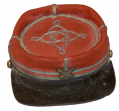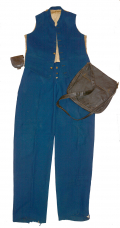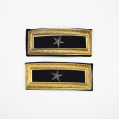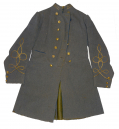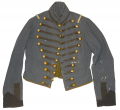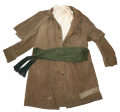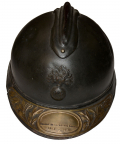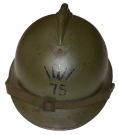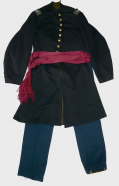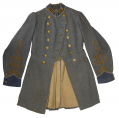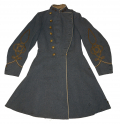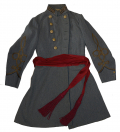site search
online catalog
Uniforms & Cloth
Showing 1 to 20 out of 218
IDENTIFIED CONFEDERATE ARTILLERY OFFICER'S KEPI - THE OWNER WAS KILLED IN ACTION
This has to be one of the best out there for history, its classic appearance and condition. Peyton Johnston Junior was commissioned an officer in the Virginia 3rd Cavalry Regiment on 15 Aug 1861. He… (1268-1008). Learn More »
EIGHT STAR – VIRGINIA - CONFEDERATE FIRST NATIONAL “BIBLE” FLAG
This printed Confederate First National Flag measures 7” by 3” and bears eight stars, likely dating it just after the official secession of Viriginia on April 17, 1861, and sometime before the… (286-1422). Learn More »
$395.00
SOLD
RARE STYLE JACKET WORN BY GENERAL THOMAS G. STEVENSON, KILLED IN ACTION MAY 1864 NEAR SPOTSYLVANIA COURT HOUSE
Thomas Greely Stevenson was born in Boston Massachusetts. He was 25 years old when the Civil War began. He had risen from private to major in the Massachusetts Militia very quickly. On December 3,… (1268-310). Learn More »
$39,500.00
ON HOLD
ID’D GEORGIA CONFEDERATE OFFICER’S VEST, TROUSERS, HAVERSACK AND CAP BOX
This is a great looking Confederate uniform grouping belonging to the impressively named Marshall H.A. DeGraffenreid, a Lieutenant in the “First Georgia Regulars” from 1862 to 1865, who saw action… (1268-046). Learn More »
$9,500.00
SOLD
EXCELLENT CONDITION SMITH PATENT BRIGADIER GENERAL’S SHOULDER STRAPS
Smith patent shoulder straps used a gilt stamped brass border imitating the dead and bright bullion of embroidered shoulder straps, and were more robust, easier to maintain and less expensive, making… (142-111). Learn More »
$2,250.00
Originally $2,750.00
SOLD
1863 PATTERN US CAVALRY GUIDON FROM THE 1st CONNECTICUT CAVALRY
This cavalry guidon was formerly in the personal collection of Jim Stamatelos, well known Civil War collector, dealer, and major contributor of items illustrated in the Time-Life volume “Echoes of… (433-14). Learn More »
$28,000.00
Originally $35,000.00
IDENTIFIED CONFEDERATE OFFICER'S FROCK COAT WITH EXTRAORDINARILY RARE BUTTONS
Offered is the uniform coat of 2nd/1st Lieutenant John Calhoun Clemson. This fine frock coat has 20 rare "CS Palmetto Guards" overcoat and cuff buttons (SC17). John Calhoun Clemson was the grandson of… (1268-056). Learn More »
ANTEBELLUM/CONFEDERATE VIRGINIA CAVALRY TROOPER"S JACKET
This is a really great looking cavalry shell jacket. It was probably made just prior to the war and later modified as the war progressed. This short jacket is made of dark gray wool broadcloth. It is… (1268-365). Learn More »
$15,000.00
ON HOLD
ORIGINAL CIVIL WAR OFFICER’S MAROON SASH
This is an original Civil War officer’s sash in very good condition. Worn by officers in most of the branches of the United States Army, the waist sash was a common uniform accoutrement that… (1268-781). Learn More »
$550.00
SOLD
IDENTIFIED CONFEDERATE "TAIT TYPE" JACKET
This is a rare, published, artillery shell jacket made by Peter Tait of Ireland. It was run through the Union Blockade for the Confederacy. We will present this offering in 5 parts: 1) The Tait story.… (1268-552). Learn More »
12-STAR YACHT ENSIGN: “A PRESENT FROM ADM. FARRAGUT.”
This yacht ensign is rather unusual in having twelve stars rather than thirteen, but when waving in a breeze it would be hard to keep count and there certainly would be no doubt about the nature of… (2025-1182). Learn More »
A CONFEDERATE SURGEON'S GREATCOAT, SASH AND SHIRT
Dr. J. P. Rasser was contracted by the Confederacy and among his duties in Georgia was the examination of Conscripts for the Army. THE OVERCOAT or army great coat is certainly "Homespun" that is a… (1268-706). Learn More »
MORTON’S BATTERY FLAG OF FORREST’S CAVALRY: EX-GUNTHER COLLECTION, CHICAGO HISTORICAL SOCIETY, & TEXAS CIVIL WAR MUSEUM
This is one of two wartime Confederate flags flown by Capt. John W. Morton consecutively as guidons for his battery or simultaneously with one likely as the battery flag and the other as a personal or… (1286-621). Learn More »
WW1 FRENCH HELMET WITH VETERAN’S PLAQUE
A very clean example of the French M1915 Adrian helmet with very strong paint, comb and RF/bomb plate in place, as well as liner and chinstrap (detached on one end) and carrying an excellent example… (1202-705). Learn More »
WW1 ITALIAN HELMET, EX-JARRETT MUSEUM
A fine example of the Italian M1917 World War One helmet with original strong green paint and black painted Italian five-prong crown with the regimental number below. The comb is in place, as is the… (1202-696). Learn More »
US WW1 28th KEYSTONE DIVISION HELMET
A very nice World War One U.S. helmet with original rough sand finish, complete liner and chinstrap, with the tightening instruction label still there, showing an original painted red Keystone, 28th… (1202-704). Learn More »
$225.00
ON HOLD
CAPTAIN’S FROCK COAT, TROUSERS AND SASH OF FREDERICK SCHUMACHER 6th WISCONSIN; LATER KIA AS MAJOR 21st WISCONSIN AT PERRYVILLE
This Union infantry captain’s frock coat, trousers and sash are in excellent condition and were worn by Frederick Schumacher of Milwaukee during his service with the 6th Wisconsin. Born in Denmark… (1268-304). Learn More »
$13,500.00
SOLD
CLOSE TO REGULATION VIRGINIA CONFEDERATE CAPTAIN'S FROCK COAT
The coat is made of mid- gray wool, possibly imported from England. It has full-length skirts ending in the typical and desirable raw edge. The sleeves have an 8 1/2-inch billow at the elbow. The dark… (1268-060). Learn More »
CONFEDERATE MAJOR CRITTENDEN'S COLONEL'S FROCK COAT
This begs an explanation! This Confederate Officer Charles T. Crittenden grew up near Cedar Mountain, Virginia. When the Civil War began, he was elected a Lieutenant in Company B, 13th Virginia this… (1268-064). Learn More »
A SOUTH CAROLINA CONFEDERATE CAPTAIN'S SUPERB FROCK COAT
Worn by Robert Chisolm who formed Chisolm's Company, 1st Battalion South Carolina Sharpshooters on July 23,1862 after service in the artillery. This unit subsequently became Company A, 1st South… (1268-1006). Learn More »
Showing 1 to 20 out of 218
Most Popular
Historical Firearms Stolen From The National Civil War Museum In Harrisburg, Pa »
Theft From Gravesite Of Gen. John Reynolds »
Selection Of Unframed Prints By Don Troiani »
Fine Condition Brass Infantry Bugle Insignia »
British Imported, Confederate Used Bayonet »
Scarce New Model 1865 Sharps Still In Percussion Near Factory New »
featured item
1863 PATTERN US CAVALRY GUIDON FROM THE 1st CONNECTICUT CAVALRY
This cavalry guidon was formerly in the personal collection of Jim Stamatelos, well known Civil War collector, dealer, and major contributor of items illustrated in the Time-Life volume “Echoes of Glory:” Arms and Equipment of the Union.” We… (433-14). Learn More »



